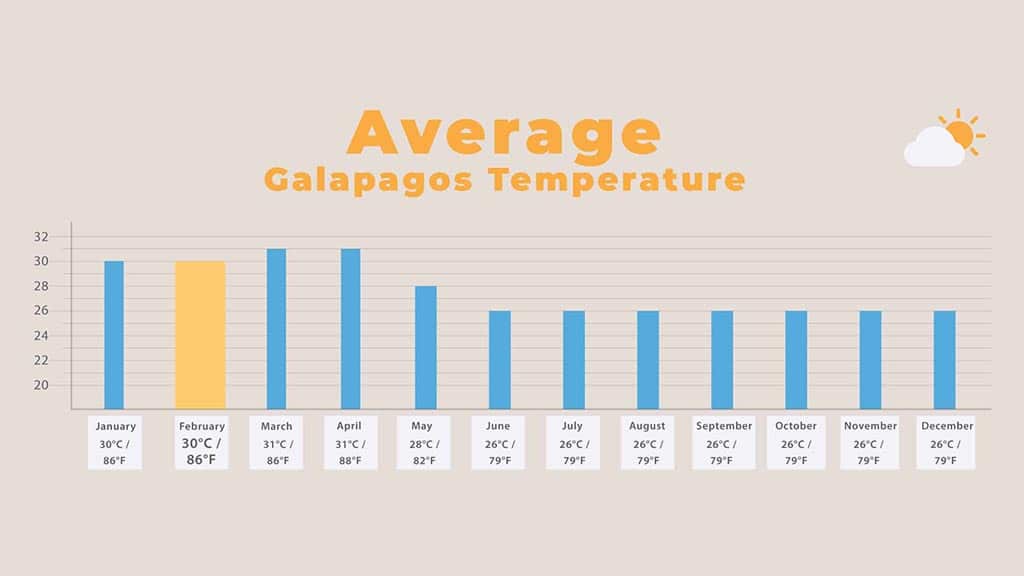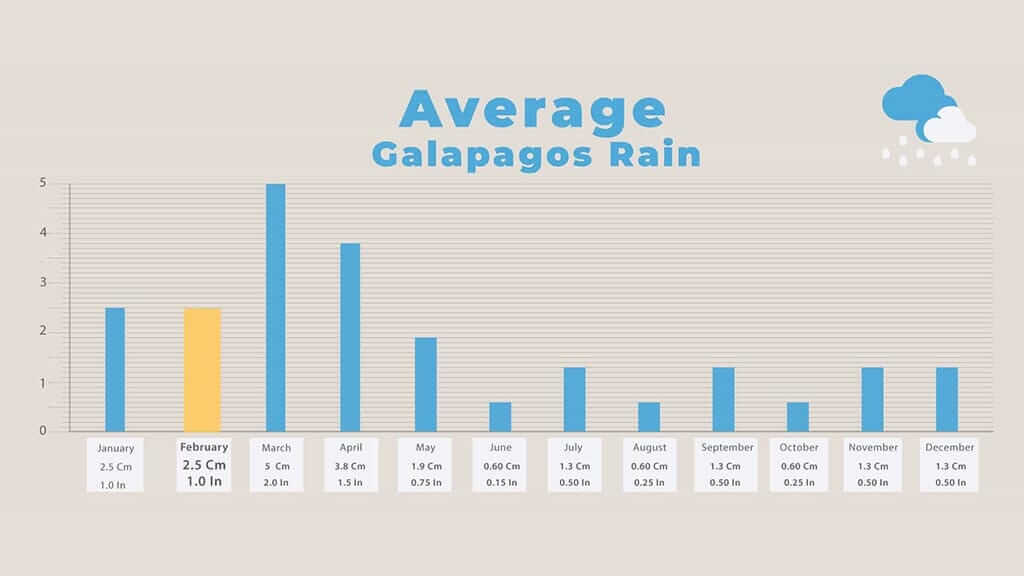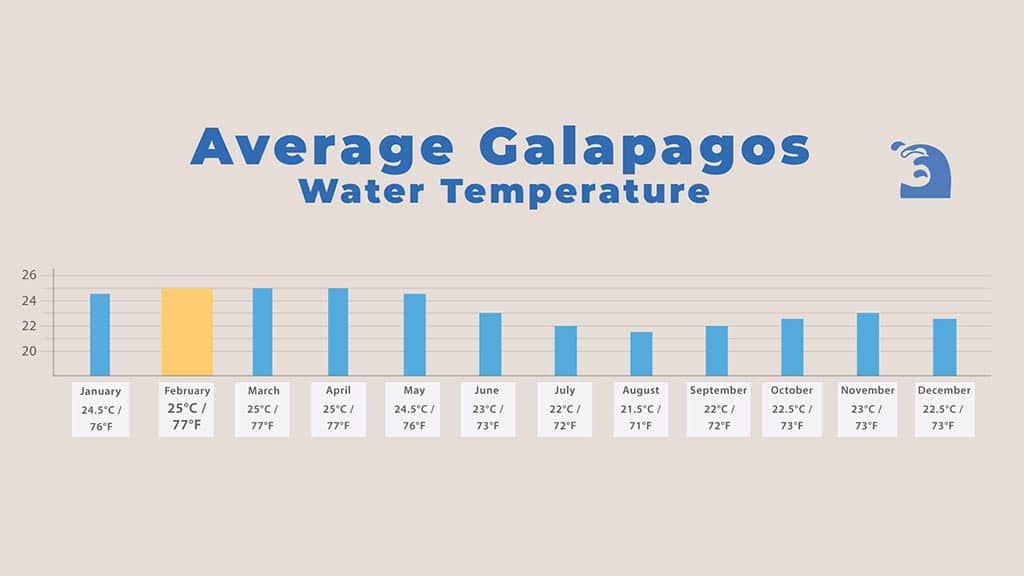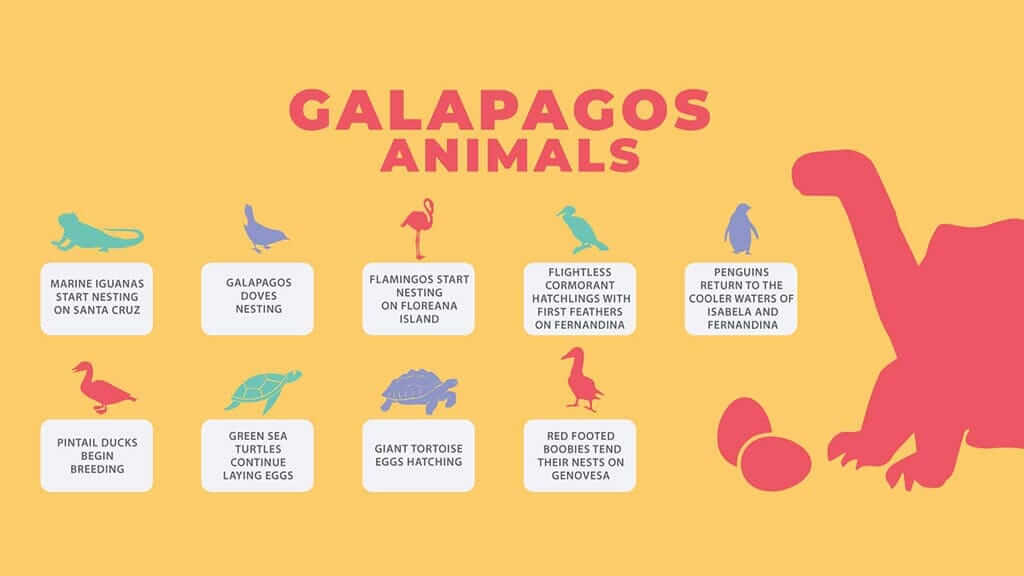Galapagos Weather in February
Is February a Good Time to Visit the Galapagos?
One of the most common questions we get asked is: when is the best month to travel to the Galapagos? Is our vacation to the Galapagos in February a good idea, or should we go in January or March? Is it too hot/cold/rainy in the Galapagos in February? Are the February Galapagos seas warm enough for swimming? Our answer is always the same – February is a great month at Galapagos, and so too are all the other months! The Galapagos Islands are an all-year-round travel destination, with comfortable weather and great wildlife viewing every month of the year. So yes, February is as good a month as any to visit Galapagos.
Read on for everything you need to know about Galapagos Weather in FEBRUARY – temperatures, rainfall, and wildlife highlights.
SECURE YOUR GALAPAGOS TRAVEL
Get a FREE personalised quote todayWhat to expect at Galapagos in February?
February Galapagos Weather Season:
February is the second month of the WARM & WET Galapagos season. Visitors should expect plenty of strong tropical sun, with occasional heavy showers, and some humidity. Sunblock, a hat, and sunglasses are a must at all times as skin tends to burn very quickly if unprotected. A light rain jacket is also recommended for land trips just in case of a heavy shower.

February Galapagos Wildlife Season:
In WARM & WET months like February, the rains and sunshine transform the island highlands into a lush and green Paradise. February in Galapagos is perfect for land species such as the Giant Tortoise, Land Iguanas, Darwin Finches & other land birds, who find food plentiful and are especially active this time of year.
Don’t worry, the Galapagos marine species are also easily spotted in February, even though the warmer seas mean fewer nutrients for them to feed on.

February Galapagos Tourist Season:
February sees REGULAR demand for Galapagos cruise spaces throughout the month. Possible exceptions are if Carnaval public holiday weekend falls during this month, then demand from Ecuadorian travelers is very high and Galapagos flight spaces may be full. February is also a good month for Galapagos Land Tours.

Galapagos Weather in February
February in Galapagos is a month of very pleasant weather - warm temperatures of an average of 30 degrees Celsius, and just 1 inch of rainfall on average falling through the month.
Most days you’ll be in shorts and a T-shirt and slapping sun cream on your back, but February Galapagos showers or drizzle are quite common in the highlands - so keep a light raincoat handy too.
Average Galapagos Temperature in February
Rainfall at Galapagos in February
GET FREE ADVICE
From a Galapagos destination expert todayGalapagos Water Temperature in February
In February the Galapagos water temperature is pleasantly warm on average (25 degrees Celsius), so it's a great month to get into the water swimming and snorkeling. It is not usually necessary for February Galapagos visitors to wear a wetsuit.
Galapagos Wildlife in February
Is February in Galapagos a good month for wildlife? Remember, every month at the Galapagos Islands (including February) is amazing for wildlife spotting, and almost all land and marine species can in fact be found all year round.
That said, each month does bring something different to the archipelago. Subtle changes in Galapagos animal behavior such as breeding, nesting, hatching, feeding, growing, and migrating. The Galapagos natural world is in constant change.
One big highlight to look out for in Galapagos in February is the nesting of Marine Iguanas - they are digging burrows in preparation to lay eggs, often very close to visitor trails. Iguanas become more territorial during this time so you might even see some aggressive displays by males hoping to protect their mate.
Some bird species are also starting to nest in February. Flamingos start to build their impressive conical nests at Cormorant Point (Floreana). Flamingos are very cautious at this time of year - if their nest is disturbed in any way they will often abandon it. Look out for Pintail Duck nests in the same area, as well as Galapagos Dove nesting sites across the archipelago.
Other birds are more advanced in their breeding seasons. Red-footed boobies are tending their nests and eggs on Genovesa island, while baby Flightless Cormorant chicks are carefully looked after by parents on Fernandina island.
Other Galapagos animals active in February include green sea turtles and giant tortoises. Turtles are laying eggs on Galapagos beaches. Mothers crawl ashore at night to dig nests where they lay hundreds of eggs, safely buried away from predators. Visitors can see telltale flipper trails on beaches such as Bachas (Santa Cruz), and sometimes red flags put up by park rangers to identify nests and enable coordinated protection of the region. Meanwhile, Giant Galapagos tortoise eggs begin hatching on the flat and sandy lowlands. Hatchlings have to survive alone for the first years of their life but are given a helping hand at tortoise breeding centers. Here they are protected from invasive species like cats and dogs, later to be re-released when large enough to look after themselves.
For visitors who want to spot Galapagos penguins, it is worth noting that these cute little fellas begin returning to Isabela and Fernandina islands during this month. While it is still possible to spot penguins at Bartolome Island throughout the year, they become fewer in number.
Check out the infographic below for some of the special wildlife highlights to expect at Galapagos in February.
We really hope that this February in Galapagos blog was useful for trip planning. If you are looking for a complete summary of the Galapagos climate across the year, then also check out our general Galapagos Weather blog.
If you need any help planning your Galapagos Vacation (in February or any other month!), then just drop us a line.
Happy Gringo has over 18 years of experience as the trusted choice in Galapagos travel and has received special recognition from TripAdvisor for 8 consecutive years. We specialize in Galapagos Cruises, Diving Tours, and Custom-Made Galapagos Land Trips. We’d love to hear from you
The #1 Trusted
Galapagos Travel Agency
In conclusion, Galapagos Weather in February makes it a great month to visit the Galapagos islands. Enviable temperatures, lots of sunshine, and only occasional showers are perfect for suntans. The warm seas make for comfortable snorkeling. The highlands come to life with lush green vegetation. Plus there are top wildlife spotting opportunities right across the archipelago.








